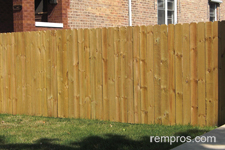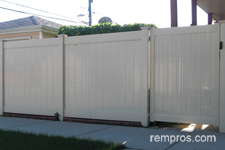Which fencing material is better? |
|
VS |
|
|
Pressure-treated wood fence |
|
|
|
Natural look of wood. After installation wood fence can be stained or painted in any desired color.
|
5 |
|
4 |
Available in wide range of styles and designs. Most popular colors are white, grey, and brown.
|
|
No restriction to installation around any property.
|
5 |
|
5 |
Good choice for residential property.
|
|
Wood is a good low cost material for building security fences.
|
4 |
|
3 |
Many vinyl fences are not designed for security purposes, but some products have a high level of security.
|
|
Depends on fence design, but pressure-treated wood is a good option for building privacy fences.
|
5 |
|
5 |
Solid vinyl panes are a great material for building privacy fences.
|
|
Very susceptible to open fire. |
1 |
|
2 |
|
|
Good resistance to impact. |
4 |
|
3 |
Vinyl fences have fair resistance to impacts and could be physically damaged. |
Termites and insects resistance
|
Termites can easily damage the wood fence. |
1 |
|
5 |
Impervious to insects or termites. |
|
|
1 |
|
5 |
|
|
|
- |
|
- |
|
|
Pressure-treated wood is durable material, but can be damaged by heavy abuse. |
4 |
|
3 |
Vinyl fence is fairly durable, but can be physically damaged. |
|
|
3 |
|
2 |
|
|
Pressure-treated wood fences have shortest lifespan compare to other fence materials. Often should be replaced in 10 – 15 years.
|
1 |
|
3 |
With adequate care quality vinyl fence can last over 25 years. |
|
High maintenance fencing material. |
5 |
|
1 |
Normally do not require much of a care besides regular cleaning. |
|
One of the cheapest fencing materials. |
1 |
|
3 |
Prices for vinyl fences widely vary, but typically it is more expensive material compare to pressure-treated wood fence. |
Installation cost (labor)
|
Charges to install one linear foot of pressure-treated wood fence are lowest compare with any other fencing options.
|
1 |
|
2 |
Labor fees for vinyl fence installation could be slightly higher in comparison with building wood fence.
|
|
Building a wood fence is one of the easiest tasks. |
1 |
|
2 |
Installation of vinyl fence is not a hard project.
|
|
Building 50 – 60 feet of standard pressure treated lumber fence with simple 36” wide gate typically is a couple days project for a crew of 3.
|
1 |
|
1 |
Crew of three normally is able to install 65 - 70 feet of vinyl fence in 2 days. |
|
Wood fence is easy to repair. |
1 |
|
2 |
Damaged sections of vinyl fence can be easily replaced with new ones. |
|
Fence posts installed too far from each other (normally distance should be 8 feet in between wood fence posts). Fence posts inadequately set into the ground. Wood starts rot because of skipping periodical maintenance. Poor built and mounted gates.
|
5 |
|
3 |
Improper installed posts. Discoloring of vinyl fence normally happened because of low quality materials itself or poor maintenance.
|
Pressure-treated wood and vinyl are good fencing options with their own advantages and disadvantages. Wood is very easy to work with material and pressure-treated fence is very affordable what makes it even more attractive to many homeowners. Vinyl fence typically last longer and require less maintenance in comparison with wood fence.









 1 Rating was estimated on the scale from 1 to 5, accounting 1 as lowest and 5 as the highest quality of a product. Always consider the fact: not all products made equally the same and performance of particular fence significantly depends on individual product quality, adequate installation, and proper maintenance.
1 Rating was estimated on the scale from 1 to 5, accounting 1 as lowest and 5 as the highest quality of a product. Always consider the fact: not all products made equally the same and performance of particular fence significantly depends on individual product quality, adequate installation, and proper maintenance.